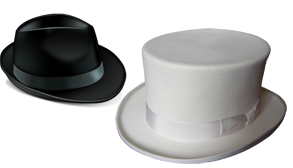SEO Singapore SEO = Search Engine Optimization | Local and Worldwide
A Singapore SEO Service you can trust.
Which Hat Do You Wear?
There’s something to be said for the old-fashioned campy movies of the sixties. Poor acting and lack of special effects aside, those movies are classics for a reason. One of the biggest being identifiable characters. A guy bent over his beer at the bar in black boots, a black shirt and a black  cowboy hat sporting three days worth of stubble and an ominous violin score in the background leaves no doubt in your mind who he is. The antagonist. The enemy. The bad guy. Enter Set ‘em Straight Steve. Clean shaven, crisp light shirt and, most importantly, a white hat. The hero. The good guy. The one we root for.
cowboy hat sporting three days worth of stubble and an ominous violin score in the background leaves no doubt in your mind who he is. The antagonist. The enemy. The bad guy. Enter Set ‘em Straight Steve. Clean shaven, crisp light shirt and, most importantly, a white hat. The hero. The good guy. The one we root for.
Things aren’t quite so black and white anymore. While most audiences are looking for the ‘best bad guy’ to be the hero of our movies nowadays, we still like for our everyday lives to have clearly defined ‘good guys’ and ‘bad guys’. White hats, and black hats, if you will. This is true, even when it comes to our online interactions.
The term Search Engine Optimization (SEO) was coined around 1997 and web developers started trying to come up with ways to make search engines find their site and rank it the highest. Which, in turn, got them more hits, more visitors, and more money.
In the beginning, anything went and developers came up with all kinds of clever, sneaky SEO tactics to get crawlers to rank their sites. But, as is usually the case, a couple of bad seeds ruined the whole crop and somebody had to crack down on the developer’s shady, though ingenious tactics. In response to the new rules search engines started creating, web developers began to part into two groups: the rule followers (white hats) and the rule breakers (black hats).
White hats, or the ethical hackers, are the developers that understand the short term effects of bad SEO. Yeah, you’ll get lots of hits and a high ranked site on search engines…at first. But it’s only a matter of time before the likes of Google or Yahoo! catch on and your site is banned. Instead, white hats have taken on the role almost that of a reformed criminal. Familiar with the tactics used by his ‘bad guy’ counterparts, a white hat hacker might find himself employed by big companies or even the military to try and break into their secure files and websites, thus alerting them to weaknesses in their system.
Then there are the black hats. These guys don’t just break the rules, they generally don’t care really care that they exist. In fact, there are whole websites where these seedy characters of the internet underworld can get together to discuss techniques and share new ideas on message boards. Their tactics are varied and sundry, and relatively effective. Temporarily. Strategies like invisible text, writing a keyword over and over in the same color text as that of the background or doorway pages that automatically redirect a user to a site other than that the one he originally intended, will fool crawlers at first. But this is just bad SEO. It’s a short term solution and in the end, it’s probably not worth the time, energy and money it takes to constantly try and stay one step ahead of the ever-improving search engine spiders and recreate new websites to replace the ones that have been banned, just to make a few bucks and get to the top of the list for a day.
SEO has grown and evolved and along the way, driven a wedge in the community of web developers at large. In the end, everyone must choose their side. A white hat, or a black hat. Ethical or not. It is a personal choice, one we all must make for ourselves. But let us not forget: the dark side may have cookies, but I think we all know who we’ll be on our feet for when the credits finally roll.

![Validate my RSS feed [Valid RSS]](/images/valid-rss-rogers.png)